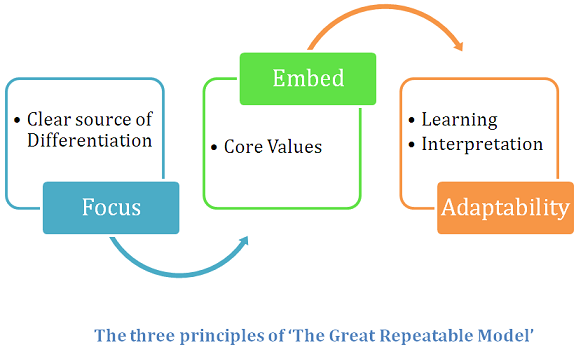In their book, Repeatability: Build Enduring Businesses for a World of Constant Change authors Chris Zook and James Allen, outline design principles of successful businesses. These principles were termed the “Great Repeatable Model”. Companies that adopt these principles can repeat their success, hence the name repeatable model. According to the authors, there are three key principles:
- Principle of Focus
- Principle of Embeddedness
- Principle of Adaptability

As per the first principle, companies need to identify how they differentiate in comparison to others. Faced with new markets or changes, identification of a clear source of differentiation gives the company an edge over others. Many companies believe they have differentiation, but customers might disagree. At this point, a genuine leader can identify the gaps to fill in and remodel to deliver things differently.
E.g., Apple was able to repeat its success with the iPod, iPhone and the iPad. Apple provides its customers with a high quality product that has excellent design. All its products aim at superior user experience. With iTunes integration, a customer is at ease with the entire range of products.
The second principle emphasizes core values that a company must strive for and embed it into their culture. A leader must drive these core values and be in-sync with the employees. The core values must drive all major decisions the company makes. A customer must identify with these core values when he/she interfaces with the product or service provided by the company.
E.g., Google has been successful with many products like Search, Gmail and many others. Google’s core values – focus on the user and rest will follow, fast is better than slow or great is not just good enough. A customer identifies these core values in each of Google’s products and company founders communicate and live these values as well.
The third principle is straightforward. A company has to adapt to changes. With failure or competitors catching up, it has to question its assumptions and adapt its model. It is essential therefore that a company learns and the rate at which it learns (or measures its product or service quality and performance). However, learning is not enough. A correct interpretation of the learning helps in repeating success.
E.g., Zara the world’s leading fashion retailer deployed a new process to deliver shipment to its stores (more than 1500) globally from its two warehouses in Spain by relying on operations research techniques. Zara was able to build an innovative and highly responsive design, production and distribution structure. By determining the best shipment quantities to deliver, it was able to increase its sales by 3 to 4% in 2007 and 2008.
